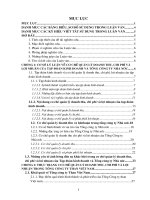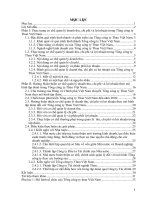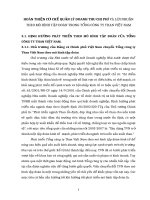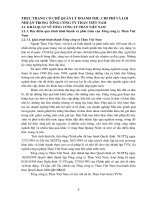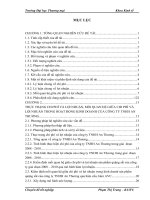Bài 7: Hàm chi phí và lợi nhuận
Bạn đang xem bản rút gọn của tài liệu. Xem và tải ngay bản đầy đủ của tài liệu tại đây (431.01 KB, 49 trang )
<span class='text_page_counter'>(1)</span><div class='page_container' data-page=1>
THE DUALITY APPROACH:
COST AND PROFIT
FUNCTIONS
</div>
<span class='text_page_counter'>(2)</span><div class='page_container' data-page=2>
The primal vs duality approach
Derivation of cost and profit function
</div>
<span class='text_page_counter'>(3)</span><div class='page_container' data-page=3>
Production Economics
optimal allocation of resources in the production of
goods and services given
technology
resource constraints
output demand (and thus prices of outputs)
prices of inputs
Basic issues:
optimal input uses
</div>
<span class='text_page_counter'>(4)</span><div class='page_container' data-page=4>
The primal vs dual approach
Primal approach
optimal input and output levels are obtained by solving
the optimization problem
Dual approach
Inputs demand and output supply functions can be
derived from the dual functions
max
<i>x</i>
<i>pf x</i>
<i>wx</i>
min
st
<i>c</i>
<i>x</i>
<i>wx</i>
<i>y</i>
<i>f x</i>
</div>
<span class='text_page_counter'>(5)</span><div class='page_container' data-page=5>
Problems of the primal approach
endogeneity and simultaneity of the production function
(
<i>need instrumental variables, and more advanced techniques to </i>
<i>fix</i>
)
multicollinearity of inputs in the production function (
<i>may </i>
<i>result in incorrect estimates, sometimes unable to obtain the </i>
<i>estimates</i>
)
for some functional forms, it is hard to obtain input demands
and output supply (
<i>the optimization is not always easy</i>
)
</div>
<span class='text_page_counter'>(6)</span><div class='page_container' data-page=6>
Specification of the cost function
Cost min problem
Lagrangian function
FOCs
Solving FOCs to obtain
Cost function
min
st
<i>c</i>
<i>x</i>
<i>wx</i>
<i>y</i>
<i>f x</i>
<i>c</i>
<i>L x</i>
<i>wx</i>
<sub></sub>
<i>y</i>
<i>f x</i>
<sub></sub>
<sub> </sub>
0 i
<i>i</i>
<i>i</i>
<i>L x</i>
<i>w</i>
<i>f x</i>
<i>x</i>
,
conditional factor demand
<i>c</i>
<i>x</i>
<i>x</i>
<i>w y</i>
,
,
<i>c</i>
<i>c</i>
<i>wx</i>
<i>w y</i>
<i>c w y</i>
</div>
<span class='text_page_counter'>(7)</span><div class='page_container' data-page=7>
Specification of the profit function
Profit max problem
FOCs
Solve FOCs to get
Substitute
into
to obtain
max
<i>x</i>
<i>pf x</i>
<i>wx</i>
0 i
<i>i</i>
<i>i</i>
<i>pf x</i>
<i>wx</i>
,
unconditional factor demand
<i>x</i>
<i>x p w</i>
<i>pf x</i>
<i>wx</i>
,
<i>x</i>
<i>x p w</i>
<i>p w</i>
,
</div>
<span class='text_page_counter'>(8)</span><div class='page_container' data-page=8>
Properties
Issues in estimation
</div>
<span class='text_page_counter'>(9)</span><div class='page_container' data-page=9>
Properties of the cost function
1
2
3
4
5
6
7 Shephard lemma
Symmetry by Young theorem
,
0 for ,
0
<i>c w y</i>
<i>w y</i>
,
is non-decreasing in
<i>c w y</i>
<i>w</i>
,
is non-decreasing in
<i>c w y</i>
<i>y</i>
,
is linearly homogenous in
<i>c w y</i>
<i>w</i>
,
is continuous and concave in
<i>c w y</i>
<i>w</i>
,
<sub></sub>
<sub></sub>
,
<i>c</i>
<i>i</i>
<i>i</i>
<i>c w y</i>
<i>x</i>
<i>w y</i>
<i>w</i>
, 0
0
<i>c w</i>
2
2
,
,
,
,
so
<i>c</i>
<i>c</i>
<i>j</i>
<i>i</i>
<i>i</i>
<i>j</i>
<i>j</i>
<i>i</i>
<i>j</i>
<i>i</i>
<i>x</i>
<i>w y</i>
<i>c</i>
<i>w y</i>
<i>c</i>
<i>w y</i>
<i>x</i>
<i>w y</i>
<i>w w</i>
<i>w w</i>
<i>w</i>
<i>w</i>
</div>
<span class='text_page_counter'>(10)</span><div class='page_container' data-page=10>
Issues in estimating the cost function
Factor cost shares sum to 1
Homogeneity
</div>
<span class='text_page_counter'>(11)</span><div class='page_container' data-page=11>
Factor cost share
The factor cost shares sum to 1
For the translog cost function
The cost share equations are
,
<sub></sub>
,
<sub></sub>
,
<i>c</i>
<i>i</i>
<i>i</i>
<i>i</i>
<i>w x</i>
<i>w y</i>
<i>s w y</i>
<i>c w y</i>
<i><sub>i</sub></i>
,
1
<i>i</i>
<i>s w y</i>
1
ln
ln
ln
ln
ln
ln
2
<i>i</i>
<i>i</i>
<i>ij</i>
<i>i</i>
<i>j</i>
<i>i</i>
<i>i</i>
<i>i</i>
<i>i</i>
<i>j</i>
<i>i</i>
<i>c</i>
<i>w</i>
<i>w</i>
<i>w</i>
<i>w</i>
<i>y</i>
ln
ln
ln
ln
<i>i</i>
<i>i</i>
<i>i</i>
<i>ij</i>
<i>j</i>
<i>i</i>
<i>j</i>
<i>i</i>
<i>i</i>
<i>i</i>
<i>w</i>
<i>c</i>
<i>c</i>
<i>s</i>
<i>w</i>
<i>y</i>
<i>w c</i>
<i>w</i>
</div>
<span class='text_page_counter'>(12)</span><div class='page_container' data-page=12>
Homogeneity of the cost function
Proportional changes in input prices leave factor
demand unchanged
For the translog cost function, linear homogeneity is
satisfied if
,
,
0
<i>c tw y</i>
<i>tc w y</i>
<i>t</i>
1
<i>i</i>
<i>i</i>
<i><sub>ij</sub></i>
0
<i>i</i>
<i><sub>i</sub></i>
0
<i>i</i>
1
ln
ln
ln
ln
ln
ln
2
<i>i</i>
<i>i</i>
<i>ij</i>
<i>i</i>
<i>j</i>
<i>i</i>
<i>i</i>
<i>i</i>
<i>i</i>
<i>j</i>
<i>i</i>
</div>
<span class='text_page_counter'>(13)</span><div class='page_container' data-page=13>
Monotonicity
The cost function must be increasing in w
For the translog cost function
ln
ln
0
<i>i</i>
<i>i</i>
<i>ij</i>
<i>j</i>
<i>i</i>
<i>j</i>
<i>i</i>
<i>i</i>
<i>i</i>
<i>i</i>
<i>c</i>
<i>c</i>
<i>c</i>
<i>s</i>
<i>w</i>
<i>y</i>
<i>i</i>
<i>w</i>
<i>w</i>
<i>w</i>
<sub></sub>
<sub></sub>
</div>
<span class='text_page_counter'>(14)</span><div class='page_container' data-page=14>
Concavity
The cost function must be concave in w
</div>
<span class='text_page_counter'>(15)</span><div class='page_container' data-page=15>
Symmetry
Cross price effects of factor demand are equal
2
2
,
,
,
,
or
<i>c</i>
<i>c</i>
<i>j</i>
<i>i</i>
<i>i</i>
<i>j</i>
<i>j</i>
<i>i</i>
<i>j</i>
<i>i</i>
<i>x</i>
<i>w y</i>
<i>c</i>
<i>w y</i>
<i>c</i>
<i>w y</i>
<i>x</i>
<i>w y</i>
<i>w w</i>
<i>w w</i>
<i>w</i>
<i>w</i>
</div>
<span class='text_page_counter'>(16)</span><div class='page_container' data-page=16>
In empirical studies
Cost shares: estimated simultaneously with the cost
function (system of equations)
Homogeneity, monotonicity, convavity and symmetry
are either:
</div>
<span class='text_page_counter'>(17)</span><div class='page_container' data-page=17>
Uses of the cost function
Factor demand
Output supply
Morishima elasticity of substitution
,
,
<i>c</i>
<i>i</i>
<i>i</i>
<i>c w y</i>
<i>x</i>
<i>w y</i>
<i>w</i>
,
<sub></sub>
<sub></sub>
1
<sub></sub>
<sub></sub>
,
,
<i>c w y</i>
<i>mc w y</i>
<i>p</i>
<i>y</i>
<i>mc</i>
<i>w p</i>
<i>y</i>
,
ln
,
ln
<i>i</i>
<i>j</i>
<i>ij</i>
<i>j</i>
<i>i</i>
<i>c w y</i>
<i>c</i>
<i>w y</i>
</div>
<span class='text_page_counter'>(18)</span><div class='page_container' data-page=18>
Example: Ray (1982)
Title: A translog cost function analysis of U.S.
agriculture 1939-1977
Objectives
measure elasticity of substitution
measure price elasticity of factor demand
measure technical change
</div>
<span class='text_page_counter'>(19)</span><div class='page_container' data-page=19>
Example: Ray (1982)
Data
2 outputs
livestock
crop
5 inputs
hired labor
capital (real estate, motor vehicles and machinery)
fertilizers
purchased feed, seed and livestock
miscellaneous inputs
</div>
<span class='text_page_counter'>(20)</span><div class='page_container' data-page=20>
Example: Ray (1982)
Estimated equations:
cost function
cost share equations
revenue share equations
Functional form: translog cost function
Dependent variables:
farm production expense (index)
cost shares
</div>
<span class='text_page_counter'>(21)</span><div class='page_container' data-page=21>
Example: Ray (1982)
Technical change in the cost function
ln
<i>c w y</i>
,
<i>t</i>
</div>
<span class='text_page_counter'>(22)</span><div class='page_container' data-page=22>
Example: Ray (1982)
Treatment for properties of the cost function
homogeneity: imposed
monotonicity: ignored
concavity: ignored
symmetry: ignored
Findings
declining substitutability between capital and labor
price elasticity increase over time for all inputs
</div>
<span class='text_page_counter'>(23)</span><div class='page_container' data-page=23>
Properties
Issues in estimation
</div>
<span class='text_page_counter'>(24)</span><div class='page_container' data-page=24>
Properties of the profit function
1
2
3
4
5
6 Hotelling lemma
7 Symmetry
<i>p w</i>
,
0
<i>p w</i>
,
non-decreasing in p
<i>p w</i>
,
non-increasing in w
<i>p w</i>
,
linear homogeneous in
<i>p w</i>
,
<i>p w</i>
,
continuous and convex in
<i>p w</i>
,
,
<sub></sub>
<sub></sub>
,
<i>k</i>
<i>k</i>
<i>p w</i>
<i>y</i>
<i>p w</i>
<i>p</i>
,
<sub></sub>
<sub></sub>
,
<i>i</i>
<i>i</i>
<i>p w</i>
<i>x</i>
<i>p w</i>
<i>w</i>
,
,
,
,
so
<i>i</i>
<i>k</i>
<i>i</i>
<i>i</i>
<i>k</i>
<i>i</i>
<i>k</i>
<i>p w</i>
<i>p w</i>
<i>y p w</i>
<i>x p w</i>
<i>p w</i>
<i>w p</i>
<i>w</i>
<i>p</i>
</div>
<span class='text_page_counter'>(25)</span><div class='page_container' data-page=25>
Issues in estimating the profit function
Homogeneity
Monotonicity
Convexity: Hessian matrix positive semi-definite
Symmetry
<i>tp tw</i>
,
<i>t</i>
<i>p w</i>
,
<i>t</i>
0
,
0
<i>k</i>
<i>p w</i>
<i>p</i>
,
0
<i>i</i>
<i>p w</i>
<i>w</i>
,
,
<i>k</i>
<i>i</i>
<i>i</i>
<i>k</i>
<i>p w</i>
<i>p w</i>
<i>p w</i>
<i>w p</i>
</div>
<span class='text_page_counter'>(26)</span><div class='page_container' data-page=26>
Issues in estimating the profit function
Although not required, profit function is usually
estimated together with the revenue share
equations
and the input expenditure share equations
<sub></sub>
<sub></sub>
ln
,
,
,
ln
<i>y</i>
<i>k</i>
<i>k</i>
<i>k</i>
<i>k</i>
<i>k</i>
<i>k</i>
<i>p w</i>
<i><sub>p w p</sub></i>
<i><sub>y p</sub></i>
<i>s</i>
<i>p w</i>
<i>p</i>
<i>p</i>
<sub></sub>
<sub></sub>
ln
,
,
,
ln
<i>x</i>
<i>i</i>
<i>i</i>
<i>i</i>
<i>i</i>
<i>i</i>
<i>i</i>
<i>p w</i>
<i><sub>p w w</sub></i>
<i><sub>x w</sub></i>
<i>s</i>
<i>p w</i>
</div>
<span class='text_page_counter'>(27)</span><div class='page_container' data-page=27>
Example: Alpay et al (2002)
Title: Productivity growth and environmental
regulations in Mexican and U.S. food manufacturing
Objective: compare productivity growth of Mexican
</div>
<span class='text_page_counter'>(28)</span><div class='page_container' data-page=28>
Example: Alpay et al (2002)
Methodology
profit function + revenue share equations +
expenditure share equations
profit: short-run profit (capital fixed)
functional form: translog profit
</div>
<span class='text_page_counter'>(29)</span><div class='page_container' data-page=29>
Example: Alpay et al (2002)
Data: aggregate
output: restricted short-run profit
Inputs
labor
material
pollution abatement expenditure
</div>
<span class='text_page_counter'>(30)</span><div class='page_container' data-page=30>
Example: Alpay et al (2002)
Dual productivity growth from the profit function
The primal productivity growth could be derived
from the dual productivity growth
technical changes that are unaffected by prices
ln
<i>p w</i>
,
<i>t</i>
</div>
<span class='text_page_counter'>(31)</span><div class='page_container' data-page=31></div>
<span class='text_page_counter'>(32)</span><div class='page_container' data-page=32>
Primal and dual, what can they do?
estimate factor demand
estimate output supply
factor substitution
technical changes
</div>
<span class='text_page_counter'>(33)</span><div class='page_container' data-page=33>
Advantages of duality approach
sometimes it’s hard to solve the optimization
problem for the primal production function
in production function, inputs are very likely to be
co-linear (more than prices)
dual functions are more convenient to analyze
</div>
<span class='text_page_counter'>(34)</span><div class='page_container' data-page=34>
Disadvantages of duality
Prices are also co-linear
Properties/restrictions of the dual functions
(homogeneity, monotonicity, concavity and
symmetry)
</div>
<span class='text_page_counter'>(35)</span><div class='page_container' data-page=35></div>
<span class='text_page_counter'>(36)</span><div class='page_container' data-page=36>
The data – rice production activity
</div>
<span class='text_page_counter'>(37)</span><div class='page_container' data-page=37>
Preparing data
* GENERATING VARIABLE COST
gen cost = urea * p_urea + npk * p_npk
gen lcost = ln(cost)
* Generating log-var
gen lp_urea = ln(p_urea)
gen lp_npk = ln(p_npk)
gen loutput = ln(output)
* GENERATING INTERACTION TERMS
gen lp_urea2 = lp_urea * lp_urea
gen lp_npk2 = lp_npk * lp_npk
gen lp_urea_npk = lp_urea * lp_npk
gen loutput2 = loutput*loutput
</div>
<span class='text_page_counter'>(38)</span><div class='page_container' data-page=38>
The Cobb-Douglas production function
_cons -2.443404 .386535 -6.32 0.000 -3.201219 -1.685588
loutput .9030405 .014217 63.52 0.000 .8751676 .9309133
lp_npk .5981721 .2857531 2.09 0.036 .0379434 1.158401
lp_urea .5704618 .2956906 1.93 0.054 -.0092499 1.150173
lcost Coef. Std. Err. t P>|t| [95% Conf. Interval]
Total 5900.28906 4163 1.41731661 Root MSE = .84356
Adj R-squared = 0.4979
Residual 2960.26013 4160 .711600993 R-squared = 0.4983
Model 2940.02893 3 980.009644 Prob > F = 0.0000
F( 3, 4160) = 1377.19
Source SS df MS Number of obs = 4164
. reg lcost lp_urea lp_npk loutput
</div>
<span class='text_page_counter'>(39)</span><div class='page_container' data-page=39>
Linear homogeneity
Prob > F = 0.2546
F( 1, 4160) = 1.30
( 1) lp_urea + lp_npk = 1
. test lp_urea + lp_npk = 1
</div>
<span class='text_page_counter'>(40)</span><div class='page_container' data-page=40>
The translog cost function
_cons -20.02878 5.772784 -3.47 0.001 -31.34653 -8.711038
lout_npk -.2041232 .2942038 -0.69 0.488 -.7809201 .3726737
lout_urea .0451066 .3052942 0.15 0.883 -.5534335 .6436467
lp_urea_npk -7.073271 10.24913 -0.69 0.490 -27.16705 13.02051
loutput2 .0086156 .0091541 0.94 0.347 -.0093314 .0265625
lp_npk2 .8205222 5.340899 0.15 0.878 -9.650498 11.29154
lp_urea2 3.172856 5.40346 0.59 0.557 -7.420817 13.76653
loutput 1.11335 .4502833 2.47 0.013 .2305538 1.996146
lp_npk 15.02131 8.356314 1.80 0.072 -1.361537 31.40416
lp_urea 1.189279 8.8623 0.13 0.893 -16.18557 18.56413
lcost Coef. Std. Err. t P>|t| [95% Conf. Interval]
Total 5900.28906 4163 1.41731661 Root MSE = .84238
Adj R-squared = 0.4993
Residual 2947.68538 4154 .70960168 R-squared = 0.5004
Model 2952.60369 9 328.067076 Prob > F = 0.0000
F( 9, 4154) = 462.33
Source SS df MS Number of obs = 4164
</div>
<span class='text_page_counter'>(41)</span><div class='page_container' data-page=41>
Cobb-Douglas or Translog?
Prob > F = 0.0071
F( 6, 4154) = 2.95
( 6) lout_npk = 0
( 5) lout_urea = 0
( 4) lp_urea_npk = 0
( 3) loutput2 = 0
( 2) lp_npk2 = 0
( 1) lp_urea2 = 0
</div>
<span class='text_page_counter'>(42)</span><div class='page_container' data-page=42>
Testing linear homogeneity of the
Translog cost function
Prob > F = 0.0018
F( 3, 4154) = 5.03
( 3) lout_urea + lout_npk = 0
( 2) lp_urea2 + lp_npk2 + lp_urea_npk = 0
( 1) lp_urea + lp_npk = 1
> */ (lout_urea + lout_npk = 0)
> */ (lp_urea2 + lp_npk2 + lp_urea_npk = 0) /*
. test (lp_urea + lp_npk = 1) /*
</div>
<span class='text_page_counter'>(43)</span><div class='page_container' data-page=43>
Imposing linear homogeneity on the
Translog cost function
constraint 1 lp_urea + lp_npk = 1
constraint 2 lp_urea2 + lp_npk2 + lp_urea_npk = 0
constraint 3 lout_urea + lout_npk = 0
cnsreg lcost lp_urea lp_npk loutput lp_urea2
</div>
<span class='text_page_counter'>(44)</span><div class='page_container' data-page=44>
Imposing linear homogeneity on the
Translog cost function
_cons -1.257867 .5809441 -2.17 0.030 -2.396828 -.1189055
lout_npk -.1345858 .2770172 -0.49 0.627 -.6776877 .4085162
lout_urea .1345858 .2770172 0.49 0.627 -.4085162 .6776877
lp_urea_npk -5.672884 10.25086 -0.55 0.580 -25.77006 14.42429
loutput2 .0106869 .0083695 1.28 0.202 -.0057219 .0270957
lp_npk2 1.937082 5.07915 0.38 0.703 -8.020767 11.89493
lp_urea2 3.735802 5.236984 0.71 0.476 -6.531487 14.00309
loutput .7192963 .1365959 5.27 0.000 .4514953 .9870973
lp_npk 6.290339 3.880915 1.62 0.105 -1.31833 13.89901
lp_urea -5.290339 3.880915 -1.36 0.173 -12.89901 2.31833
lcost Coef. Std. Err. t P>|t| [95% Conf. Interval]
( 3) lout_urea + lout_npk = 0
( 2) lp_urea2 + lp_npk2 + lp_urea_npk = 0
( 1) lp_urea + lp_npk = 1
</div>
<span class='text_page_counter'>(45)</span><div class='page_container' data-page=45>
Translog cost with cost share equation
snpk 4164 3 .3089158 0.0133 57.27 0.0000
lcost 4164 9 .8416739 0.5001 10431.41 0.0000
Equation Obs Parms RMSE "R-sq" chi2 P
Three-stage least-squares regression
> */ (snpk lp_npk lp_urea loutput), constraint(4 5 6 7)
. reg3 (lcost lp_urea lp_npk loutput lp_urea2 lp_npk2 loutput2 lp_urea_npk lout_urea lout_npk) /*
. constraint 7 [snpk]loutput = [lcost]lout_npk
. constraint 6 [snpk]lp_urea = [lcost]lp_urea_npk
. constraint 5 [snpk]lp_npk = [lcost]lp_npk2/2
. constraint 4 [snpk]_con = [lcost]lp_npk
. gen snpk = npk*p_npk/cost
. * Generating cost share for npk
</div>
<span class='text_page_counter'>(46)</span><div class='page_container' data-page=46>
Translog cost with cost share equation
lp_urea_npk lout_urea lout_npk
Exogenous variables: lp_urea lp_npk loutput lp_urea2 lp_npk2 loutput2
Endogenous variables: lcost snpk
_cons 1.116778 .1409364 7.92 0.000 .8405478 1.393008
loutput .0089511 .0051982 1.72 0.085 -.0012372 .0191393
lp_urea -.3792256 .065678 -5.77 0.000 -.5079522 -.2504991
lp_npk .0304985 .0428719 0.71 0.477 -.0535289 .1145258
snpk
_cons -20.84974 5.387569 -3.87 0.000 -31.40918 -10.2903
lout_npk .0089511 .0051982 1.72 0.085 -.0012372 .0191393
lout_urea -.1963716 .1491281 -1.32 0.188 -.4886574 .0959141
lp_urea_npk -.3792256 .065678 -5.77 0.000 -.5079522 -.2504991
loutput2 .0064543 .0085096 0.76 0.448 -.0102242 .0231328
lp_npk2 .0609969 .0857438 0.71 0.477 -.1070579 .2290517
lp_urea2 -2.505675 .7265642 -3.45 0.001 -3.929715 -1.081635
loutput 1.238252 .4167321 2.97 0.003 .421472 2.055032
lp_npk 1.116778 .1409364 7.92 0.000 .8405478 1.393008
lp_urea 14.70696 3.820055 3.85 0.000 7.219785 22.19412
lcost
</div>
<span class='text_page_counter'>(47)</span><div class='page_container' data-page=47>
Testing homogeneity
Prob > chi2 = 0.0009
chi2( 3) = 16.38
( 3) [lcost]lout_urea + [lcost]lout_npk = 0
( 2) [lcost]lp_urea2 + [lcost]lp_npk2 + [lcost]lp_urea_npk = 0
( 1) [lcost]lp_urea + [lcost]lp_npk = 1
> */ (lout_urea + lout_npk = 0)
> */ (lp_urea2 + lp_npk2 + lp_urea_npk = 0) /*
. test (lp_urea + lp_npk = 1) /*
</div>
<span class='text_page_counter'>(48)</span><div class='page_container' data-page=48>
Imposing homogeneity
snpk 4164 3 .3089154 0.0133 69.54 0.0000
lcost 4164 6 .8430911 0.4984 10572.17 0.0000
Equation Obs Parms RMSE "R-sq" chi2 P
Three-stage least-squares regression
> */ (snpk lp_npk lp_urea loutput), constraint(4 5 6 7 8 9 10)
. reg3 (lcost lp_urea lp_npk loutput lp_urea2 lp_npk2 loutput2 lp_urea_npk lout_urea lout_npk) /*
. constraint 10 [lcost]lout_urea + [lcost]lout_npk = 0
. constraint 9 [lcost]lp_urea2 + [lcost]lp_npk2 + [lcost]lp_urea_npk = 0
. constraint 8 [lcost]lp_urea + [lcost]lp_npk = 1
</div>
<span class='text_page_counter'>(49)</span><div class='page_container' data-page=49>
Imposing homogeneity
lp_urea_npk lout_urea lout_npk
Exogenous variables: lp_urea lp_npk loutput lp_urea2 lp_npk2 loutput2
Endogenous variables: lcost snpk
_cons 1.16657 .1309565 8.91 0.000 .9099001 1.42324
loutput .0084214 .0051685 1.63 0.103 -.0017087 .0185515
lp_urea -.388852 .065142 -5.97 0.000 -.516528 -.2611761
lp_npk .0201149 .0410971 0.49 0.625 -.0604339 .1006637
snpk
_cons -1.5325 .4902529 -3.13 0.002 -2.493378 -.5716221
lout_npk .0084214 .0051685 1.63 0.103 -.0017087 .0185515
lout_urea -.0084214 .0051685 -1.63 0.103 -.0185515 .0017087
lp_urea_npk -.388852 .065142 -5.97 0.000 -.516528 -.2611761
loutput2 .0082655 .0077823 1.06 0.288 -.0069875 .0235185
lp_npk2 .0402298 .0821942 0.49 0.625 -.1208678 .2013275
lp_urea2 .3486222 .0628382 5.55 0.000 .2254615 .4717829
loutput .7699614 .1236369 6.23 0.000 .5276375 1.012285
lp_npk 1.16657 .1309565 8.91 0.000 .9099001 1.42324
lp_urea -.1665701 .1309565 -1.27 0.203 -.4232402 .0900999
lcost
</div>
<!--links-->
